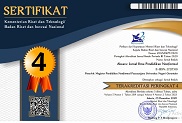Lukisan Pemandangan: Teknik Spon Dalam Karya Seni Lukis Jelekong
Abstract
Nature is a theme that is always present in the development of art in the world, both Western and Asian arts, such as China and Indonesia. The visualization can be a literal or abstract representation. Nature can be an additional element to a painting to convey depth, or perspective. However, the depiction of nature in a painting can also be the main focus of a work of art. In Indonesia itself, there is an Art Village, precisely Jelekong Art Village, where hundreds of people work as painters and some have made nature the main focus of their work. The uniqueness of the Jelekong painter's work lies in the method used and the materials used. So that the authors are interested in further researching the uniqueness of this Jelekong technique. The purpose of this research is to examine the comparison of natural visualization techniques and aspects of Jelekong painting which represent nature in terms of methods and materials. The samples in this study were paintings by Jelekong artists and Western artists. The qualitative descriptive method is considered the most appropriate for analyzing Jelekong painting. The result of this research is that the superiority of the art technique of Ugong painting is the sponge technique created by one of its residents. This technique can create shadow, middle tone, and highlight in a painting. Jelekong's paintings can become the identity of the community in cultivating the local potential of the region
Keywords
Full Text:
PDFReferences
Balik, G., & Balık Lökçe, D. (2019). On the Relationship of Landscape and Painting. AM Journal of Art and Media Studies, 19, 29-44. https://doi.org/10.25038/am.v0i19.305
Creswell, J. W. (2014). Penelitian Kualitatif dan Desain Riset. Pustaka Pelajar.
Indrobo, C. (2012). He Who Is Leaving … The Figure of the Wanderer in Nietzsche's Also sprach Zarathustra and Caspar David Friedrich's Der Wanderer über dem Nebelmeer. Nietzsche-Studien, 41(1). https://doi.org/https://doi.org/10.1515/niet.2012.41.1.78
Julisa, J., Parjito, P., & Putra, D. F. (2019). Persepsi Dan Partisipasi Masyarakat Kawasan Kampung Warna-Warni Terhadap Upaya Perbaikan. JPIG (Jurnal Pendidikan Dan Ilmu Geografi), 4(1), 26-40. https://doi.org/10.21067/jpig.v4i1.3108
Kleiner, F. S. (2014). Gardner's Art Through The Ages: A Concisw Western History. In S. A. Poore (Ed.), Wadsworth, Cengage Learning, USA (Third Edit). Wadsworth, Cengage Learning.
Pandanwangi, A., Sukapura Dewi, B., & Elnissi Tanok, S. (2019). Komparasi Karya Seni Lukis Mooi Indie antara Seniman Indonesia dan Seniman dari Barat Periode 1930-an. Budaya Nusantara, 2(2), 305-311. https://doi.org/https://doi.org/10.36456/b.nusantara.vol2.no2.a1968
Perbawasari, S., Dida, S., & Nugraha, A. R. (2019). Peran stakeholders dalam membangun identitas Purwakarta yang berwawasan nilai budaya lokal. PRofesi Humas Jurnal Ilmiah Ilmu Hubungan Masyarakat, 4(1), 23. https://doi.org/10.24198/prh.v4i1.21349
Setiawan, I. (2012). The Existence of Jelekong Art Village in Supporting Household Needs. Patanjala, 4(2), 58-73. https://doi.org/http://dx.doi.org/10.30959/patanjala.v4i2.140
Sukapura Dewi, B., Pandanwangi, A., & Prasetya, S. (2008). Kajian Seni Rupa Jelekong, Bale Endah Bandung Meningkatkan Potensi Kepariwisataan Jawa Barat. https://www.researchgate.net/publication/277735035_Kajian_Seni_Rupa_Jelekong_Bale_Endah_Bandung_Meningkatkan_Potensi_Kepariwisataan_Jawa_Barat
Sumartono. (2017). Metodologi Penelitian Kualitatif: Seni Rupa. Universitas Trisakti.
DOI: http://dx.doi.org/10.37905/aksara.7.1.103-110.2021
Refbacks
- There are currently no refbacks.
Copyright (c) 2021 Aksara: Jurnal Ilmu Pendidikan Nonformal

This work is licensed under a Creative Commons Attribution-ShareAlike 4.0 International License.
Publisher:
Magister Pendidikan Nonformal Pascasarjana Universitas Negeri Gorontalo
Jl. Soedirman No. 06 Gorontalo 96128 e-mail: jurnalaksara@ung.ac.id
http://ejurnal.pps.ung.ac.id







